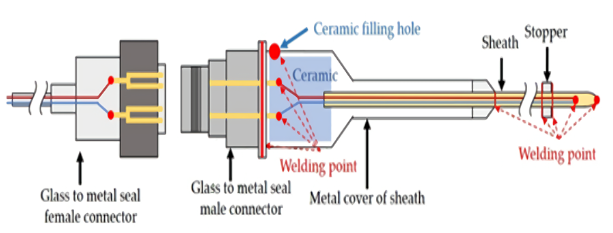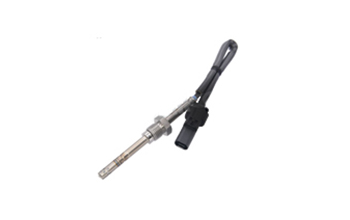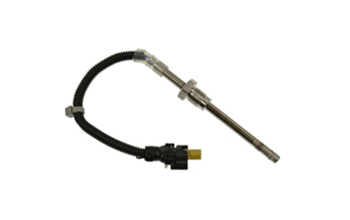EGT Sensor
EGT sensors detect the exhaust temperatures and send signals to the ECU. Too-high temperatures indicate problems, which is the reason that we want good EGT sensors. Come to Delcoribo for your need.

Engines Need EGT Sensors to Prevent Excessive Temperatures
Small Size And Outstanding Anti-Vibration. Monitor Wild Range of Temperatures with High Accuracy. Good Responsiveness for Optimal Fuel Injection Timing. Professional Engineering to Reduce Ageing.
1. Introduction
The exhaust gas temperature (EGT) sensor applies to the temperature regulation of the diesel particulate filter (DPF). It detects the exhaust gas temperature and converts it into a voltage. The message is for the electronic control system analysis. The sensor sets the temperature required for the DPF to reduce emissions and harmful gases to the atmosphere.

The exhaust gas discharges from the combustion chamber. After passing through the high-speed rotating turbine, the gas rests on the cross-section outlet. The exhaust gas temperature is, in fact, the 'main indicator' of the engine's high-pressure rotor speed, swashplate position etc., so it must be very accurate.
2. Operating Principle
The indicator shows the exhaust gas temperature due to the thermocouple induction, which means that it automatically generates an inductive electric potential signal when the engine exhaust gas temperature changes. The signal is then sent to the engine integrated regulator to alert the owner that the machine is over-temperature. The signal is also sent to the parameter indicator. Finally, the message is updated to the electronic system monitor processor, which provides the engine exhaust temperature data.
3. Position of Sensor
Some high-pressure common-rail diesel vehicles equip the EGT sensor. It installs on the three-way catalytic converter or turbocharger of the vehicle's exhaust unit. The sensor detects the temperature of the exhaust gas inside the converter.
4. Thermocouple EGT Sensor
Exhaust gas temperature sensors can be divided into thermistors, thermocouples and fuse three types. The thermocouple EGT sensor has a simple structure. It is easy to use. The thermocouple type usually consists of two different metal wires. It's not limited in size and with a protective sleeve, making it very easy to use.
4.1 Features
(1) High measurement accuracy
This sensor has high measurement accuracy. The thermocouple directly contacts the measured object. It's not affected by the intermediate medium.
(2) Wide measurement range
This sensor has a relatively wide measurement range. Common thermocouple measures from -50 ~ 1600 °C continuously. Some particular thermocouples can measure as low as -269 °C, up to +2800 °C.
4.2 Circuit

The thermocouple is one of the most common temperature detection tools in the industry. The thermocouple works on the principle of the Seeback effect. Two conductors of different compositions connect at both ends to form a loop. If the two connected ends are at different temperatures, a thermal current generates in the loop.
These two different metal wires are welded together to form two junctions. The loop voltage VOUT is the difference between the junction voltage of the hot junction and the cold junction (reference junction). The VOUT is a function of the temperature difference. The proportionality factor α corresponds to the ratio of the voltage difference to the temperature difference. The α is called the Seebeck factor.
5. Working Process
The exhaust gas temperature directly reflects the cylinder combustion condition. For diesel engines, the exhaust temperature leads to post combustion. At this time, the gas and oil circuit is likely to have problems.
Generally, this sensor doesn't install on vehicles. Most of today's temperature sensors are thermocouple type with slow response time. When a car is on the road, its operating conditions are constantly changing, so the sensor doesn't reflect the current temperature in time. But the EGT sensor used in the DPF is not the same as a normal one. It has a short response time, which approximates to reflect the real-time exhaust gas temperature.
When the engine is warm, monitor the exhaust gas temperature to provide a signal for the exhaust gas recirculation valve. A high engine temperature produces nitrogen oxides (NOx), allowing a certain amount of exhaust gas to enter the cylinder and then deteriorate the combustion environment. This process makes the combustion temperature lower. You should pay attention to the exhaust gas temperature In a cold engine, too. Because the oxygen sensor and three-way catalyst both need to rise to the right temperature to work correctly.
Therefore, during the engine warm-up period, the exhaust gas temperature needs to be increased as soon as possible to reduce exhaust gas emissions. The exhaust gas temperature is a parameter that allows for better control of exhaust gas emissions.
When the engine starts, the signal switch opens, and the ignition switch turns on simultaneously. At this moment, the alarm light goes off.
When the engine starts, the signal switch disconnects. The ignition switch is on. The alarm light is on and then off, which is the function set by the manufacturer to check if the alarm light filament is fine.
During driving, when the exhaust gas temperature exceeds 900 °C, the resistance value of the EGT sensor drops below 0.43 kΩ, at which point the alarm light is on.
When the platform floor temperature exceeds 125 °C, the resistance of the floor temperature sensor exceeds 2kΩ, at which time the alarm light is on, and the buzzer makes noise.
When the exhaust gas temperature is below 900°C, and the floor temperature is also below 125°C, the resistance of the EGT sensor is more considerable than 0.43 kΩ. The resistance of the floor temperature sensor is below 2 kΩ. The alarm light isn't on, and the buzzer doesn't make strange noise.
6. Testing Methods
(1) Visual inspection
When the ignition switch is on, the exhaust temperature indicator lights up. When the engine starts, the indicator goes off. These show that the sensor works normally.
(2) Check the componentRemove the exhaust gas temperature sensor. Heat the top 40 mm long part until it is dark red near the flame. The resistance value between the sensor terminals should be between 0.4 and 20 kΩ (for reference).
7. Reasons for Choosing Delcoribo EGT Sensors
The exhaust gas temperature sensor detects temperatures of exhaust emissions. Engines need trustworthy components to handle extreme temperatures. Vehicles require consistent measurement for smooth running. Delcoribo provides high-quality EGT sensors for customers worldwide.
Our products achieve high performance with durable materials. The advanced technology and special design makes compact construction and outstanding vibration resistance. Delcoribo EGT sensors transmit accurate signals even if temperatures suddenly changes, which protects other engine components. All parts can perform well in sophisticated working states.
Are you continuously looking for perfect manufacturer and supplier? Here is the right place. We strive to offer perfect service to give you satisfactory solutions. Whenever you want to make an inquiry, feel free to contact us.
More Top Selling EGT Sensors
 EGT1169 CHEVROLET EGT Sensors
EGT1169 CHEVROLET EGT Sensors
 EGT1087 MERCEDES-BENZ EGT Sensors
EGT1087 MERCEDES-BENZ EGT Sensors
 EGT1123 DODGE EGT Sensors
EGT1123 DODGE EGT Sensors
 EGT1010 FORD EGT Sensors
EGT1010 FORD EGT Sensors
